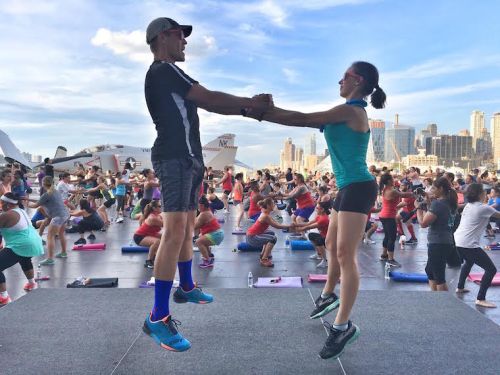Our editors independently select these products. Making a purchase through our links may earn Well+Good a commission
Jordan Metzl, MD, is serious about high-intensity interval training. So much so that HIIT is becoming his go-to Rx.
The New York City physician has been trying to build bridges between fitness and medicine for years now. In fact, in his book, Dr. Jordan Metzl’s Workout Prescription, he makes the argument that HIIT is a workout that—despite some of the pumped-up rhetoric out there—is not just for the super fit.
Dr. Metzl believes it can be accessible to people of all ages and fitness levels, and comes with incredible health benefits for those with minimal time and equipment. (To that end, the book includes lots of at-home body-weight workouts that range from 10 to 30 minutes, so you can literally jump right in.)
“What I tried to do is use both the role of doctor and fitness instructor to offer the best information on the science of intensity…and how people can get the most benefit [from exercise] within the least amount of time,” he explains.
“I want people to not be afraid of intensity; I want them to embrace intensity.”
The only thing Dr. Metzl doesn’t like about HIIT? The name, which he says can make the type of training sound scary. “It sounds daunting to people,” he explains. “I want people to not be afraid of intensity; I want them to embrace intensity.”
To help you do just that, we talked to Dr. Metzl about some of the common myths around HIIT to bring you these five surprising facts.

1. HIIT is no more dangerous than less intense forms of exercise
In fact, Dr. Metzl fell in love with HIIT after it helped him rehab his own sports injury many years ago. “I can get people’s entire kinetic chain stronger in a shorter period of time, which prevents injury,” he explains.
Many fitness injuries are also due to overuse, especially among runners, and since HIIT is short, it eliminates many of those risks (think repetitive striking of your foot on the pavement). Dr. Metzl says he has kids as young as 9 up to adults as old as 80 that come to his classes and do the workout safely—you just have to focus on form and not go overboard in terms of training. “I’d recommend a couple times a week, not every day,” he notes.

2. HIIT has many research-backed benefits beyond burning fat
HIIT gets the most attention for its ability to deliver major afterburn (AKA your body will continue to burn calories at a faster rate long after you’re done sweating). But the science Dr. Metzl lays out in his book goes way beyond that effect.
HIIT has also been shown to help people with type 2 diabetes control blood sugar, for example, and to impact appetite so you may eat less. Think of it as the workout friend with benefits.

3. HIIT can improve your athletic performance elsewhere
You may be thinking, “But I’m a runner!” In which case, you should definitely be adding intense intervals into your workout routine.
Dr. Metzl presents several studies in which researchers found runners and cyclists who incorporated HIIT into their training programs improved both their endurance and speed more than those who did not.

4. Ten minutes of HIIT really does make a difference
It may be hard (impossible?) to believe that working out for 10 minutes a few times a week could be enough. But while this kind of routine won’t turn you into an Olympian or give you bodybuilder muscles, studies have shown that doing HIIT for that small amount of time can have all of the same benefits (i.e. cardio health and lower blood pressure) as working out for much longer periods of time at a lower intensity (AKA steady-state cardio).
The key? You just have to really push yourself while you’re in it. “The further out of your comfort zone you go, the more beneficial it can be,” Dr. Metzl says. “The easiest way to measure is just by your ‘huffing and puffing scale.’ The more you’re huffing an puffing, the more you’re working. Get comfortable with being in that zone for 70–80 percent of the workout.”

5. HIIT sounds like torture, but people actually find it fun
That aforementioned huffing-and-puffing effort may sound miserable, but Dr. Metzl presents studies that show people often prefer HIIT-style workouts to “continuous moderate” exercise and even perceive the workouts to be easier than continuous exercise, even when the intensity is much higher.
Anecdotally, he says among the people who come to his classes consistently, they tend to seem like they’re having a really good time. “Thinking about fun is really important when thinking about consistency of exercise programs,” he says, because then people are further inspired by changes in their body and energy levels. “In terms of what people can do to stay motivated, the results piece of HIIT training is easy to see and can happen very quickly.”
Another thing that the fitness crowd can’t stop talking about right now? HILIT (high-intensity, low-impact workouts). Plus, why you might want to avoid doing HIIT workouts two days in a row.
Originally published December 7, 2016; updated June 4, 2018.
Sign Up for Our Daily Newsletter
Get all the latest in wellness, trends, food, fitness, beauty, and more delivered right to your inbox.
Got it, you've been added to our email list.











